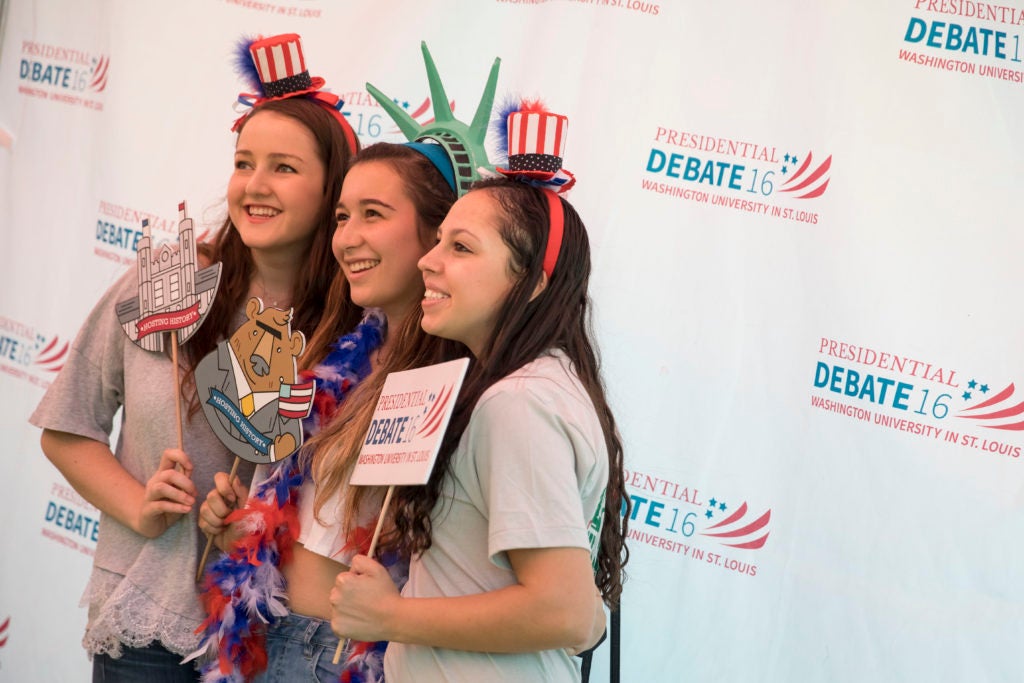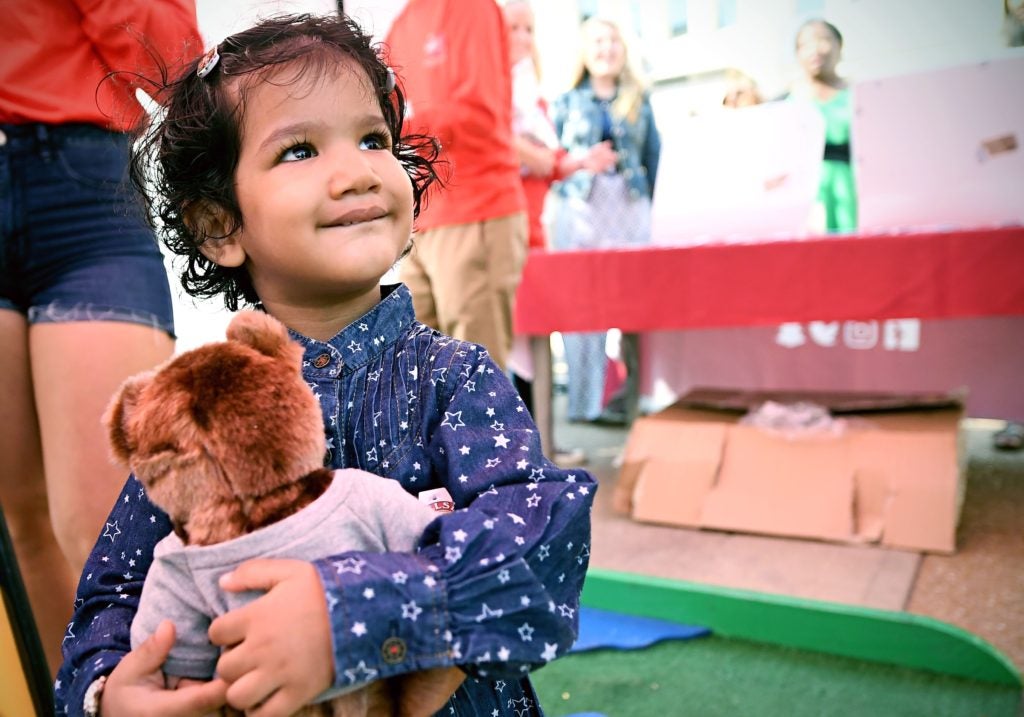
Washington University students pose for a photo at the selfie booth outside the Danforth University Center Oct. 9, 2016. (Photo: Whitney Curtis/Washington University)
The excitement surrounding the Oct. 9 debate at WashU was shared with the world via social media, resulting in an unprecedented level of audience engagement for the university. From behind-the-scenes photos of Spin Alley to student activities to observations about the debate itself, Twitter and Instagram users made full use of the #WashUdebate2016 hashtag. Debate hashtag posts numbered more than 11,000 and can be viewed online at debate.wustl.edu.
Snapchat also sent two representatives to campus for the debate, producing a five-minute “Our Story” segment titled “Debate Day” that included snaps from WashU students as well as comments from media figures and political surrogates. For those on campus, Snapchat also made available a special debate geofilter, an image that can appear over snaps submitted only from a certain area.
Cassaundra Moore, director of new media strategy at WashU, described the significance of Snapchat storytelling: “When we read an article, we’re reading that article from one author’s voice, whereas with Snapchat’s live or featured stories, everyone can contribute. It’s the true essence of what social media is meant to be — taking the idea of sharing information and being collaborative and piecing that all together.” In true Snapchat fashion, the story was there for the day and gone the next, but while it was active, the curated footage offered a look inside a campus buzzing with excitement.
While the use of the debate hashtag can’t be accurately tracked on Facebook due to varied privacy settings, the level of engagement with WashU’s Facebook page can. “Our results on Facebook are above and beyond anything I could have imagined going into the debate,” Moore said. In the last two weeks, WashU’s Facebook page gained more than 2,000 new followers, and reactions, comments, shares and clicks have numbered in the tens of thousands. The rate of follower growth on Instagram and Twitter also doubled in the last 10 days.
“Debate day was a combination of the best possible things a social media person could ever ask for: ‘game day,’ the red carpet and Commencement all wrapped up in one,” Moore said. “It’s been a great lesson for me professionally.”
Leading up to the debate, Moore’s team planned a series of WashU social-branded pop-up tents on campus, encouraging students to share their excitement on social media. The tents proved tremendously popular, with students coming out en masse to grab a treat or play games with the hopes of winning debate hashtag-related prizes.

Visiting the Washington University campus from India, 2-year-old Ishita aka Khushi was delighted to receive a WashU debate bear after winning a round of Plinko at the university’s pop-up debate social media tent Oct. 4, 2016. She was there with her father, Pradeep Agarwal, an Olin Business School Executive MBA Mumbai student. (Photo: James Byard/Washington University)
“The truth is everyone’s a winner here. You’re guaranteed to walk away with some amazing prizes, and a lucky few have gotten WashU bears and water bottles,” said Adam Hoffman, a senior in Arts & Sciences and part of the team running the social media tent. Other debate swag giveaways included posters, laptop stickers, temporary tattoos and more.
Students lined up for the pop-up tent’s selfie booth as well. Among them was Arts & Sciences freshman Sara Hendrix and her friends, waiting to pose with debate-themed props. “I’m so excited. I’m going to post it, I’m going to send it to my mom, I’m going to send it to my grandma — it’s a once-in-a-lifetime selfie,” Hendrix said.
The pop-up tent was designed to encourage students to use #WashUdebate2016, and it seems to have worked. “The debate presence on social media has been unbelievable,” Hoffman added. “I’m pretty locked in and all my friends are, too.”
“Honestly, for about the past week, every morning I’ll do a search of the hashtag on Facebook and Twitter, just to see the coverage going on,” said Jimmy Loomis, a senior and president of the College Democrats. “In fact, it’s probably been the easiest way I’ve been able to follow along with the debate.”
For Moore, the opportunity to help share the debate story has been invaluable. “I always knew this level of storytelling was possible with social media, and the debate has acted as proof positive of the power of collaboration and community,” Moore said. “This will definitely drive new ideas on how we engage our audience and tell the WashU story moving forward.”